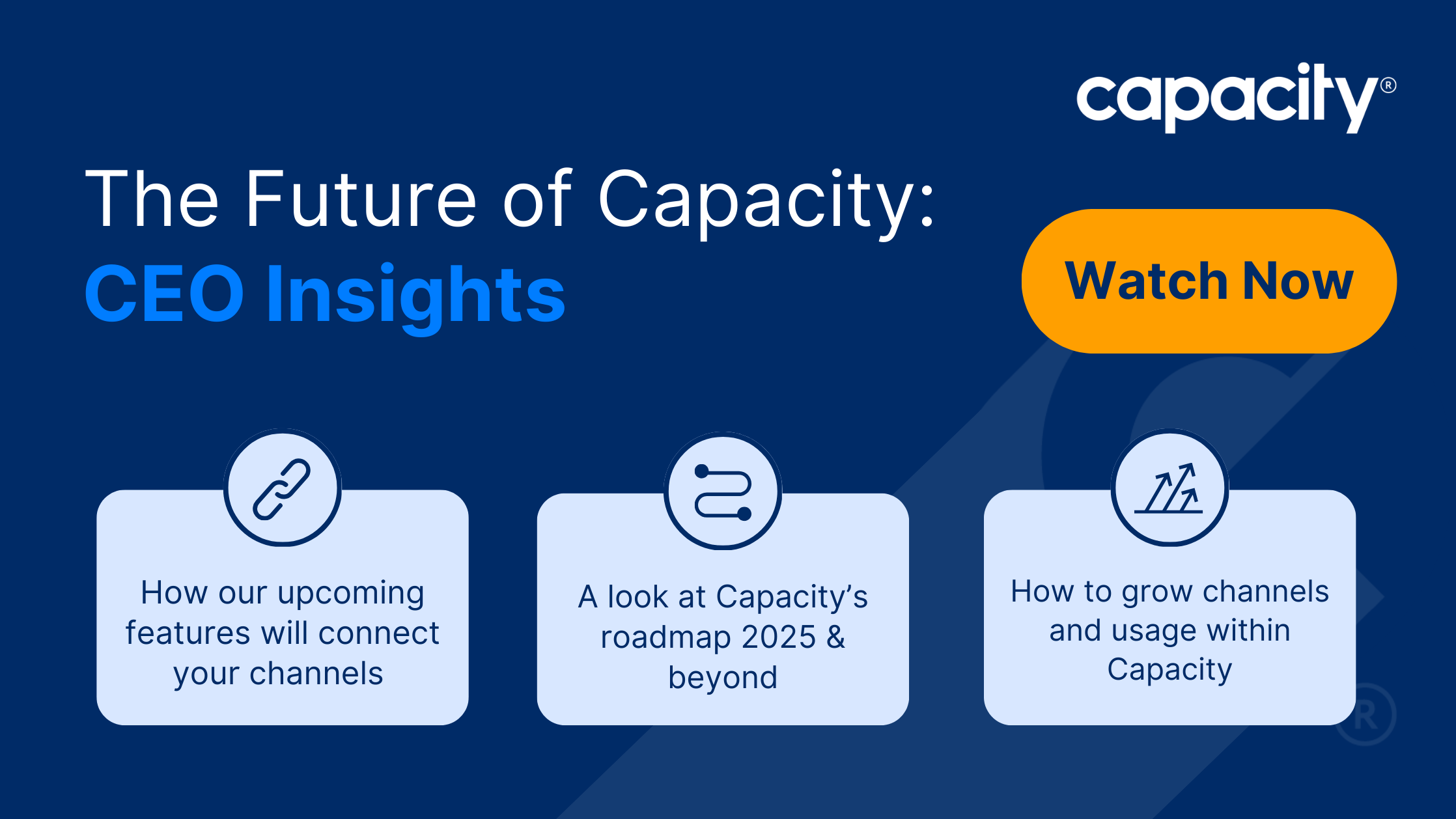Automation is transforming how businesses operate, and nowhere is this more evident than in call centers. At the heart of this transformation is process optimization, which, in a call center context, refers to improving operational efficiency, workflow, and procedures to enhance customer service and improve agent productivity. Since call centers tend to have a high turnover rate, you can offset some of your hiring needs by delegating repetitive tasks to RPA.

Automate Your Work
Capacity’s enterprise AI chatbot can help:
- Answer FAQs anytime, anywhere
- Find relevant documents within seconds
- Give surveys and collect feedback
The need for process optimization in call centers is amplified by the necessity for increased agent productivity, which directly impacts customer satisfaction and the overall success of your business. Embracing automation can propel your process optimization and boost agent productivity, paving the way for a more effective and customer-friendly call center. Here are seven areas where automation can streamline your call center operations and create a ripple effect on agent productivity.
How automation can help your process optimization
Incorporating automation in your call center operations allows you to streamline essential tactics like call routing, ensuring automated data collection and entry for the most accurate information at your fingertips. This approach not only boosts agent productivity but also elevates the customer experience to new heights. In fact, live chat is the favorite customer support channel for shoppers between the ages of 18 to 49, according to Gartner.
Streamlining call routing
In an automated call center, the distribution of calls becomes efficient and strategic. By using automated call distribution systems, calls can be strategically and efficiently directed to the most suitable agent based on predefined criteria such as skillset, language proficiency, or customer preference. Furthermore, integrating intelligent Interactive Voice Response (IVR) systems allows for personalized and automated interactions with customers before they reach an agent, helping to further reduce wait times and increase customer satisfaction. This automated routing system optimizes the call center’s workflow, thereby directly boosting agent productivity, elevating the customer experience, and driving process optimization.
Automating data entry and customer information retrieval
Automation helps in process optimization by simplifying data entry and customer information retrieval in call centers. Automated systems facilitate data capture and synchronization with your CRMs. And that then gives agents instant access to full customer data. This real-time retrieval of customer information eliminates the need for tedious, error-prone manual data entry and allows agents to respond to customer queries swiftly and accurately. The resultant decrease in resolution times leads to enhanced customer satisfaction while simultaneously freeing up agents to handle more complex tasks. Ultimately, this automation of data entry and information retrieval contributes to improved operational efficiency, a crucial aspect of process optimization.
AI-powered speech analytics
AI-powered speech analytics offers substantial benefits for process optimization in call centers. By automating the transcription and analysis of customer-agent interactions, call centers can gain valuable insights into the quality of customer engagements. AI algorithms can detect sentiment, emotions, and key indicators, allowing for a comprehensive understanding of customer needs and preferences. This data-driven approach enables targeted agent training and coaching, leading to continuous improvement in customer service. Additionally, AI-powered speech analytics facilitate effective customer engagement by identifying patterns and trends in customer interactions, enabling personalized responses and recommendations. By harnessing the power of automation in speech analytics, call centers can enhance quality monitoring, refine customer understanding, and ultimately optimize their processes to deliver exceptional customer experiences.
Intelligent chatbots and virtual assistants
Automation through the use of intelligent chatbots and virtual assistants offers a significant boost to process optimization in call centers. These automated interfaces are capable of handling routine customer inquiries and frequently asked questions, freeing up human agents to focus on more complex and high-value tasks. Powered by natural language processing, chatbots, and virtual assistants can engage in human-like interactions, providing customers with prompt and accurate responses. The 24/7 availability of these automated systems ensure uninterrupted customer support and increased first-contact resolution. Microsoft found 30% of American consumers rate chatbot interactions as “very effective” when it comes to dealing with customer service issues. By reducing the workload on agents and improving efficiency, intelligent chatbots and virtual assistants enhance process optimization in call centers. Moreover, they provide a seamless and consistent customer experience, reinforcing customer satisfaction and loyalty.
Automated workforce management
By using automated tools and systems, call centers can optimize scheduling and shift assignments based on historical data and real-time call volumes. Forecasting and resource allocation become more precise, ensuring the right number of agents are available to handle incoming calls efficiently. This streamlined workforce management improves agent satisfaction, as they are assigned shifts that align with their preferences and skills. Additionally, automation helps call centers adhere to Service Level Agreements (SLAs) by ensuring adequate staffing levels during peak hours. By optimizing workforce management processes through automation, call centers can optimize costs, increase operational efficiency, and ultimately enhance process optimization.
Robotic process automation
RPA offers huge benefits for process optimization in call centers. Repetitive and time-consuming tasks like form filling and data verification can be automated. And that then frees up valuable time for your agents to focus on more complex and value-added activities.
By adding RPA to your backend systems, your center can ensure seamless execution of processes. This then reduces manual errors and improves your operational efficiency. It also enhances data accuracy and reliability, as it follows predefined rules and standards consistently. The time-saving capabilities of RPA let your agents handle customer interactions more efficiently. And that then leads to faster query resolution and improved customer satisfaction.
Performance tracking and reporting
By automating the collection and analysis of KPIs, you get insight into your operations and can make data-driven decisions. Real-time reporting and dashboards give you a full view of your center. This lets your managers monitor key metrics like call volume, average handling time, and customer satisfaction. This automated tracking and reporting also enable proactive issue identification. Your managers can watch and identify trends, patterns, and areas for improvement. By using automation in performance tracking and reporting, your centers can foster a culture of continuous improvement. What’s more, you can make informed decisions and optimize processes for maximum efficiency and customer satisfaction.
The benefits of automation are evident, and it plays a pivotal role in process optimization in call centers. Call centers that embrace automation and process optimization will always have an edge over their competition. The steps to automation are clear, and the benefits await.
It’s time to automate and optimize.

Automate Your Work
Capacity’s enterprise AI chatbot can help:
- Answer FAQs anytime, anywhere
- Find relevant documents within seconds
- Give surveys and collect feedback












































